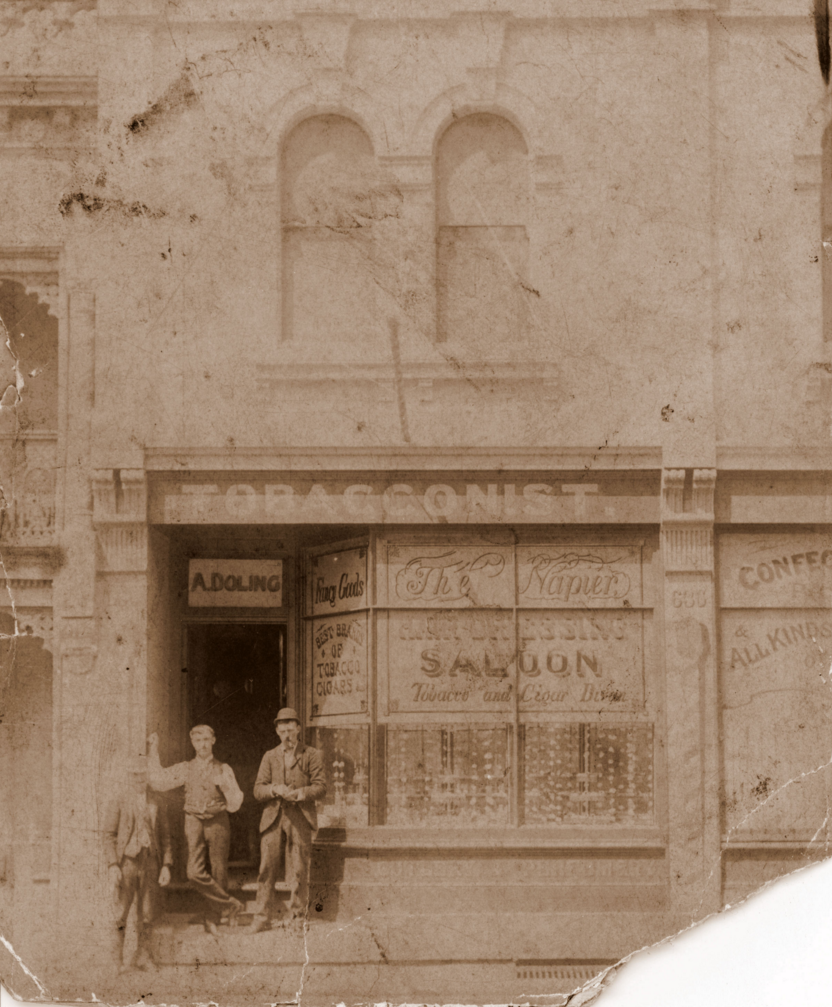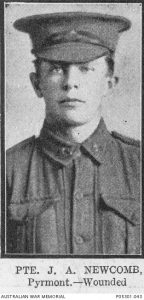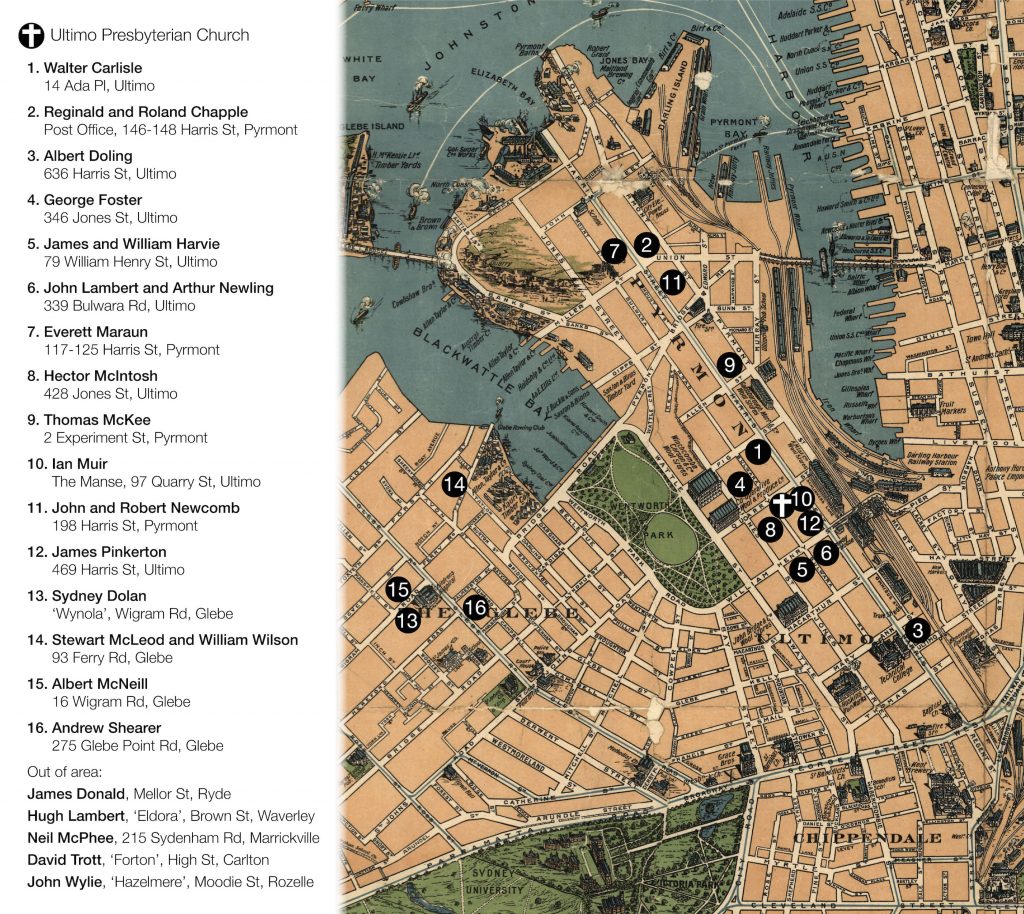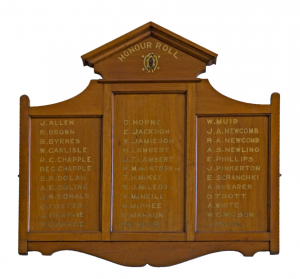Anzac Day commemorates all those who have served and died in war and on operational service. For decades a wooden World War I honour board lay in the small attic of what is now Mustard Seed Uniting Church in Ultimo. I spoke to Mitch on 2SER Breakfast about some of the stories of the servicemen listed on the roll.
Made in 1916, the honour roll features 36 names, 26 of which have been identified with reasonable certainty. Twenty-two of those were under 25 years old and at least eight misrepresented their age in order to enlist, with the two youngest being 16 and possibly 15 years old. The majority of these men lived in the vicinity of the church where the honour board was unveiled, however, some also lived in Pyrmont and Glebe.

Albert Edward Doling senior (centre) in front of his hairdressing and tobacconist saloon in Ultimo, courtesy Elaine Doling
One of the youngest, Walter Thomas Carlisle, followed his four older brothers to war. The Sydney Mail published a photograph of the 16-year-old soldier reporting he had been ‘wounded’. In reality, he was in a French hospital receiving treatment for venereal disease.
Albert Edward Doling lived above his father’s hairdressing and tobacconist saloon on Harris Street. According to family legend, Doling was punished by his superior officers because he objected to the ‘inhumane treatment’ of soldiers suffering from shell shock. Doling would later be awarded a Military Medal for ‘unselfish devotion to duty’ as a stretcher-bearer during the Battle of Menin Road in September 1917. For the rest of his life, he suffered insomnia and digestive problems as a result of being exposed to gas warfare.
But there are also stories of those who never made it home. There was 32-year-old Stewart Jamieson McLeod, who fought in what has become known as the worst 24 hours in Australian military history, the Battle of Fromelles, in July 1916. His division suffered over 5,500 casualties in one night, with 2,000 declared dead or missing. McLeod survived this battle to be killed in action a month later. His wife later donated a French souvenir embroidered handkerchief her husband had sent, to the Australian War Memorial.

J A Newcomb, courtesy Australian War Memorial
There was George Albert Foster, who lived with his parents around the corner from the Ultimo church and received several gunshot wounds in France in May 1917, dying two days later. His relatives, friends and neighbours posted a lengthy tribute in the Sydney Morning Herald, his mother posting: ‘My boy is dead, the cable tells me. / No more his native land he’ll see / But when the war is over / Still I dream he’ll come to me.’
John Alexander Newcomb was 17 years old when he enlisted. He was also wounded and convalesced in England until his health declined and he was sent back to Sydney, where he died over a year later at Randwick Military Hospital. His family were issued a Next of Kin Plaque, known colloquially as a ‘Dead Man’s Penny’, now in the collection of the War Memorial.
The war stories of these men merely scratch the surface of a much bigger picture. We may yet discover what life was like for the men who returned to Sydney, with their traumatic memories and broken bodies, to find their names inscribed on a wooden board in a small church in Ultimo.
Read my original articles in the Dictionary of Sydney on The Ultimo Presbyterian Church Roll of Honour, Returned Soldiers on the Ultimo Presbyterian Church Roll of Honour and The Fallen on the Ultimo Presbyterian Church Roll of Honour.

Addresses of men listed on the Ultimo Presbyterian Church Roll of Honour at the time of their enlistment 1914-1918, by Nicole Cama
Listen to my segment at 2SER radio. For other interesting segments, see my Dictionary of Sydney project post and visit the Dictionary of Sydney blog.


Thank you Nicole for all the work you have done BUT this World War II memorial was dedicated to the men who fought for our freedom . Most of the men on the memorial attended the Uniting church at Ultimo . The memorial should be still hanging their not moved to the Ultimo Community Centre where people don’t know its history , will these men rest in PEACE , some people should hang their heads in shame for letting this happen . If the Uniting Church had any feelings for the families of these men they would move it back to the church where it belongs . When I go to other churches I always see their war memorials on the walls . For Anzac Day 2016 I say lest I forget . Carole Twist .
Thanks for your comment Carole. While my research did not confirm if the men attended the former Ultimo Presbyterian Church, many of them at least lived very close to the church. Thank you for sharing your thoughts regarding the honour roll’s present location.
Nicole
Hi Nicole , thank you for posting my comment , can you please edit the World War11 to World War 1 , thanking you kind regards Carole .
I totally agree with Carole Twist, the World War 1 Honour Board belongs in the Church, if it was found there then it belongs there.
I find it very disrespectful that it has been moved, those parents of the soldiers went to their grave thinking that it would remain in it’s forever home.
I honestly can’t believe that someone from the church agreed to move it elsewhere .
Whats going to happen when the descendants of these families come looking for the Honour Board in the church , what is the church going to say ” oh sorry we didn’t want it here anymore ” ?
For heavens sake someone has to do the right thing ,show some respect put it back where it belongs
Regards ,
Vicki Lambley